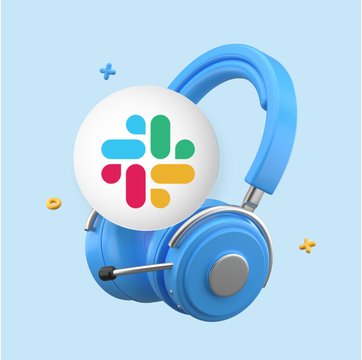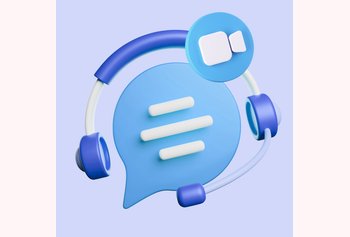
Table of contents
Transform your Gmail into a Helpdesk
How to Master Customer Support Using Slack?

Table of contents
The way teams communicate and collaborate has been changing over the years. Most of it is down to technology.
If you take the last 10 years, for instance, one piece of tech that’s changed the landscape of communication is Slack.
But here’s the best part: Slack not only serves as a means for teams in an organization to collaborate effectively but also plays a crucial role in other areas – like streamlining customer support interactions.
So, if you’re curious to know how to best use Slack for customer support, read on.
Table of Contents
- What is Slack?
- Ways to use Slack for Customer Support
- Advantages of Using Slack for Customer Support
- How to Build a Customer Support Team on Slack
- Hiver + Slack for Great Customer Support
- BONUS HACKS to leverage Slack for Customer Support
- Frequently Asked Questions (FAQ)
- Deliver Exceptional Customer Support
What is Slack?
Slack is a cloud-based collaboration tool that provides teams with a platform to communicate and work together in real time.
The name “Slack” stands for “Searchable Log of All Conversation and Knowledge.” This means, teams can easily access files, conversations, and shared information within a workspace.
Recommended Reads:
How to Connect Slack with Gmail
The Ultimate Guide to Slack Etiquette
Ways to use Slack for Customer Support
At first glance, Slack may not strike you as the obvious choice for a customer support channel. After all, it was designed for team collaboration and may not seem ideal for handling customer queries.
However, don’t dismiss it just yet. There are various other ways to make the most out of Slack for customer support.
6 ways Slack can be leveraged for efficient customer support:
- Integrate Service Cloud for Slack app to reduce incident resolution time by involving experts from various departments.
- Make use of Slack Huddles to quickly sync up with other departments before responding to customers.
- Use Slack Connect to directly involve customers in your workspace, providing them with personalized and high-quality service.
- Integrate Slack with your CRM and other support tools to seamlessly manage customer inquiries, from one unified platform.
- Use Slack’s status and availability features to optimize agent schedules. This helps you be there for customers across different time zones.
- Set up Slack alerts and reminders for SLA deadlines, ensuring timely resolution of support-related queries.
Advantages of Using Slack for Customer Support
Here are some of the advantages of using Slack for customer service:
1. Real-time Communication
Slack’s Channels allow support teams to organize customer conversations based on topics, making it easy to track and prioritize customer queries. For example, a support team can create Channels for “Billing Issues,” “Product Feedback,” or “General Inquiries.”
Support teams can collaborate within Slack Channels to resolve complex issues. For instance, when a customer inquires about a product feature, the support agent can quickly tag the product team in a dedicated Channel for expert advice.
2.Higher Customer Engagement
Slack allows support agents to engage with customers in a more relaxed manner, thereby building customer rapport. For instance, instead of scripted responses, support agents can use emojis and GIFs.
You can share news, updates, or exclusive content directly with your customers on Slack. For example: A magazine or content creator might share behind-the-scenes peeks or early access content in a #subscribers-only channel.
3.Data and Analytics
Slack’s analytics features provide valuable insights into support team performance, such as response times, resolution rates, and customer satisfaction levels. Slack can be used to collect and analyze customer feedback, helping businesses understand their pain points and areas of improvement.
4.Multichannel Support
Slack integrates with all popular social media platforms and around 2600 apps. Its customized notification settings enable support agents to prioritize urgent queries. For example, high-priority keywords like “urgent” or “down” trigger immediate notifications, ensuring the support team addresses critical matters promptly.
Did You Know: Research shows that today more than 65% of all Fortune 100 companies use Slack for business communication.
How to Build a Customer Support Team on Slack
Building a customer support team on Slack can be a highly effective way to streamline communication. Here are the steps to get started:
- Create a Slack Workspace: If you don’t already have a Slack workspace, sign up for one. You can choose a name related to your company or customer support team.
- Channels and Organization: Organize your workspace into Channels to manage different aspects of customer support. Common Channels may include #general (for team-wide announcements),#support (for customer inquiries),#feedback (for internal team discussions),and more.
- Invite Team Members: Invite team members, support agents, and anyone involved in customer support to join the workspace.
- Integrate Tools: Integrate your customer support tool with Slack. This allows you to receive notifications and updates directly in Slack. Popular integrations include ticketing systems, CRM tools, analytics platforms, and more.
- Establish Response Time Guidelines: Define response time guidelines for your team to ensure that customer inquiries are addressed promptly. You can use Slack’s reminders and notification settings to help agents stay on top of their responsibilities.
- Create Support Documentation: Develop a knowledge base or documentation library for FAQs and common issues. You can use Google Docs or other collaborative tools, and link them in the appropriate Slack channels.
Hiver + Slack for Great Customer Support
Hiver is a customer support tool designed to enhance collaboration and efficiency within teams that use Gmail to manage customer inquiries and support tickets.
The Hiver-Slack integration combines Hiver’s helpdesk functionalities with Slack’s real-time messaging – ensuring your team is able to access and respond to support tickets on time.
How to use Hiver + Slack?
Here are some ways how Hiver and Slack can be used together to offer better customer support:
- Let’s say a customer submits a ticket. Hiver can help automatically assign this ticket to an agent, and this agent can be notified on Slack about the same. The agent can work on the ticket, and keep the customer updated on their progress via Slack.
- With Hiver, you can assign incoming support emails to specific team members based on their expertise or workload. The assigned tickets can then be automatically synced to the respective Slack Channel.
- Hiver can be configured to automatically add any and all customer feedback to specific Slack channels. This way, the team can quickly review customer feedback on Slack.
- In case a ticket requires escalation to a higher level of support or to another department, you can set up rules in Hiver to notify the appropriate team or individuals through Slack.
Follow these steps to enable the Hiver-Slack integration.
BONUS HACKS to leverage Slack for Customer Support
Slack can be a powerful tool for customer support when utilized effectively. Here are some bonus hacks to leverage Slack for customer support:
#1: Create a dedicated channel (e.g., #customer-support) exclusively for customer support-related discussions. This keeps all support-related conversations organized and easily accessible to the support team.
#2: Use Slack’s “Saved Replies” feature to create canned responses for frequently asked questions. This helps speed up response times and maintain consistency in support interactions.
#3: Use Slack commands or apps like Hiver to assign support tickets to specific agents or teams. This way, the right person can handle the customer’s issue promptly.
#4: Create a separate channel for onboarding new customers. Here, you can share helpful resources, FAQs, and important updates to help customers get started smoothly.
#5: Connect Slack to your status page to automatically notify customers about ongoing incidents or planned maintenance. This helps manage customer expectations and reduces support inquiries during downtime.
#6: Set up a channel to gather customer feedback and ideas. This enables you to understand pain points, gather suggestions for improvement, and engage with your customers more effectively.
#7: Consider integrating a chatbot with Slack to handle simple and repetitive support queries, providing quick responses and freeing up human agents for more complex issues.
#8: Integrate Slack with analytics and reporting tools to track support performance metrics. This can provide insights into response times, ticket resolution, and agent performance.
#9: Foster collaboration between support and other teams (e.g., engineering, product) by creating shared channels. This enables faster issue resolution and facilitates feedback loops.
#10: Encourage agents to use emoji reactions to indicate the status of a support request (e.g., ✅ for resolved, 🕐 for in progress). This helps everyone in the team quickly see the status of different requests.
Frequently Asked Questions (FAQ)
Here are some frequently asked questions related to using Slack for customer support:
1. Can I use Slack for customer support?
Yes, Slack can be effectively used for customer support. It allows for real-time communication and collaboration among team members, and the ability to organize conversations into channels dedicated to specific topics or clients.
2. Does Slack have live chat support?
Slack itself is primarily a messaging app for teams and doesn’t offer a traditional “live chat” feature for external customer support. However, third-party apps and integrations, such as Chatlio, Acorn Chat etc., available in the Slack App Directory can enable live chat functionality with customers.
3. Is Slack good for client communication?
Slack is excellent for client communication. You can invite clients as single-channel or multi-channel guests to collaborate directly within Slack. This approach keeps communication transparent, centralized, and efficient.
4. What are some advantages of using Slack for customer service?
- Provide real-time responses to clients’ queries – provided they are invited as guests to your Slack channel.
- Categorize conversations into channels for streamlining communication.
- @mention team members for internal collaboration, consulting, and file sharing.
- Integrate with CRM systems and other tools to build seamless workflows.
- Automate repetitive tasks on Slack using bots.
5. How can I build a customer support team on Slack?
- Create dedicated channels for managing various aspects of customer support. For instance, you can have a channel to discuss all high-priority customer queries.
- Invite team members, assigning roles and responsibilities.
- Integrate with helpdesk and CRM software so that you can access customer history and past interactions without switching tabs.
- Share links to knowledge base articles for easy information access.
- Train your team on Slack best practices, including thread use, reminders, and status management.
6. Can Slack integrate with CRM and other customer support tools?
Yes, Slack integrates with many CRM and customer support tools, allowing for direct access to customer data, notifications, and actions within Slack. Integrations include popular systems like Salesforce, Hiver, HubSpot, and Zendesk.
7. How do Slack’s status and reminders benefit customer support?
- Status Updates: Help manage and distribute workload by showing team availability.
- Reminders: Ensure follow-ups on customer queries and important tasks.
Deliver Exceptional Customer Support
In conclusion, implementing Slack as a customer support tool can greatly enhance the efficiency of your customer support team.
Now with Hiver and Slack together, support agents can collaborate more seamlessly, get complete visibility into the status of tickets, and deliver prompt resolutions.
So, why wait? Try Hiver for free!

































